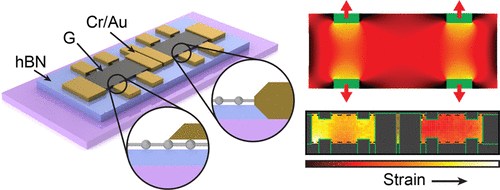当前位置:
X-MOL 学术
›
Nano Lett.
›
论文详情
Our official English website, www.x-mol.net, welcomes your
feedback! (Note: you will need to create a separate account there.)
Strain-Engineering of Twist-Angle in Graphene/hBN Superlattice Devices
Nano Letters ( IF 9.6 ) Pub Date : 2018-11-26 00:00:00 , DOI: 10.1021/acs.nanolett.8b03854 Adolfo De Sanctis 1 , Jake D. Mehew 1 , Saad Alkhalifa 1, 2 , Freddie Withers 1 , Monica F. Craciun 1 , Saverio Russo 1
Nano Letters ( IF 9.6 ) Pub Date : 2018-11-26 00:00:00 , DOI: 10.1021/acs.nanolett.8b03854 Adolfo De Sanctis 1 , Jake D. Mehew 1 , Saad Alkhalifa 1, 2 , Freddie Withers 1 , Monica F. Craciun 1 , Saverio Russo 1
Affiliation

|
The observation of novel physical phenomena such as Hofstadter’s butterfly, topological currents, and unconventional superconductivity in graphene has been enabled by the replacement of SiO2 with hexagonal boron nitride (hBN) as a substrate and by the ability to form superlattices in graphene/hBN heterostructures. These devices are commonly made by etching the graphene into a Hall-bar shape with metal contacts. The deposition of metal electrodes, the design, and specific configuration of contacts can have profound effects on the electronic properties of the devices possibly even affecting the alignment of graphene/hBN superlattices. In this work, we probe the strain configuration of graphene on hBN in contact with two types of metal contacts, two-dimensional (2D) top-contacts and one-dimensional edge-contacts. We show that top-contacts induce strain in the graphene layer along two opposing leads, leading to a complex strain pattern across the device channel. Edge-contacts, on the contrary, do not show such strain pattern. A finite-elements modeling simulation is used to confirm that the observed strain pattern is generated by the mechanical action of the metal contacts clamped to the graphene. Thermal annealing is shown to reduce the overall doping while increasing the overall strain, indicating an increased interaction between graphene and hBN. Surprisingly, we find that the two contact configurations lead to different twist-angles in graphene/hBN superlattices, which converge to the same value after thermal annealing. This observation confirms the self-locking mechanism of graphene/hBN superlattices also in the presence of strain gradients. Our experiments may have profound implications in the development of future electronic devices based on heterostructures and provide a new mechanism to induce complex strain patterns in 2D materials.
中文翻译:

石墨烯/ hBN超晶格器件中扭曲角的应变工程
通过替代SiO 2可以观察到诸如霍夫施塔特的蝴蝶,拓扑电流和石墨烯中的非常规超导性等新的物理现象。以六方氮化硼(hBN)为基材,并具有在石墨烯/ hBN异质结构中形成超晶格的能力。这些器件通常是通过将石墨烯蚀刻成具有金属触点的霍尔棒形状制成的。金属电极的沉积,触点的设计和特定配置可能会对器件的电子性能产生深远影响,甚至可能影响石墨烯/ hBN超晶格的排列。在这项工作中,我们探讨了hBN上石墨烯在与两种类型的金属接触(二维(2D)顶部接触和一维边缘接触)接触时的应变构型。我们显示,顶部接触会沿两个相对的引线在石墨烯层中引起应变,从而导致跨器件通道的复杂应变模式。相反,边缘接触没有显示出这种应变模式。使用有限元建模仿真来确认观察到的应变模式是由夹在石墨烯上的金属触点的机械作用产生的。显示出热退火可减少总掺杂,同时增加总应变,表明石墨烯与hBN之间的相互作用增加。出乎意料的是,我们发现两种接触结构在石墨烯/ hBN超晶格中导致不同的扭曲角,在热退火后收敛到相同的值。该观察结果证实了在存在应变梯度的情况下石墨烯/ hBN超晶格的自锁机制。我们的实验可能会对基于异质结构的未来电子设备的发展产生深远的影响,并提供一种在2D材料中诱导复杂应变模式的新机制。
更新日期:2018-11-26
中文翻译:

石墨烯/ hBN超晶格器件中扭曲角的应变工程
通过替代SiO 2可以观察到诸如霍夫施塔特的蝴蝶,拓扑电流和石墨烯中的非常规超导性等新的物理现象。以六方氮化硼(hBN)为基材,并具有在石墨烯/ hBN异质结构中形成超晶格的能力。这些器件通常是通过将石墨烯蚀刻成具有金属触点的霍尔棒形状制成的。金属电极的沉积,触点的设计和特定配置可能会对器件的电子性能产生深远影响,甚至可能影响石墨烯/ hBN超晶格的排列。在这项工作中,我们探讨了hBN上石墨烯在与两种类型的金属接触(二维(2D)顶部接触和一维边缘接触)接触时的应变构型。我们显示,顶部接触会沿两个相对的引线在石墨烯层中引起应变,从而导致跨器件通道的复杂应变模式。相反,边缘接触没有显示出这种应变模式。使用有限元建模仿真来确认观察到的应变模式是由夹在石墨烯上的金属触点的机械作用产生的。显示出热退火可减少总掺杂,同时增加总应变,表明石墨烯与hBN之间的相互作用增加。出乎意料的是,我们发现两种接触结构在石墨烯/ hBN超晶格中导致不同的扭曲角,在热退火后收敛到相同的值。该观察结果证实了在存在应变梯度的情况下石墨烯/ hBN超晶格的自锁机制。我们的实验可能会对基于异质结构的未来电子设备的发展产生深远的影响,并提供一种在2D材料中诱导复杂应变模式的新机制。































 京公网安备 11010802027423号
京公网安备 11010802027423号